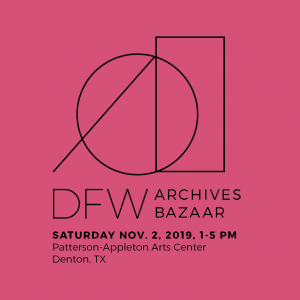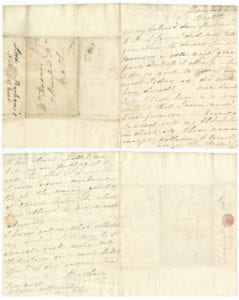Tomorrow, November 2, is the second annual DFW archives bazaar. This event will take place from 1:00pm-5:00pm at the Patterson-Appleton Arts Center in Denton, Texas.

Come visit with archivists, museum curators, librarians, and history professionals from all across the DFW area. Discover the various resources in your own backyard, learn how to preserve your family treasures, interview family members about their own history, digitize family memories, and much more. Visit the “Ask an Archivist” Station, and find out what it takes to become a professional archivist. In addition to the exhibitors and demos, there will be door prizes, trivia, and more.
My path to becoming an archivist was not straightforward. I found my way into the profession while in graduate school working on an MA in history. My first archival gig was as an intern at a local historical museum. From the moment I walked into the stacks, I was hooked.
What I love most about this profession is that every day is an opportunity to learn new things about the people, places, and events of our past. Since we just finished celebrating American Archives Month, I thought I would take an opportunity to answer a few of the questions I get asked the most on the job.
What is the oldest item in your collection?
A Columbus letter dated 29 April 1493.
What is your favorite item in the collection?

This is hard because there are just so many amazing pieces that I could never narrow it to one item. I can say that correspondence is definitely my favorite type of record. Throughout my archivist career I have read thousands upon thousands of letters from centuries old to a few weeks old, from handwritten notes to corporate form letters. Because letter writing is not instant like, say, a tweet or blog post, when I read through these letters I imagine a person sitting down to write out their thoughts and feelings. Combine this with a knowledge of time and place and you can get a visual image of what that particular day in their life was like.
Why don’t you just put everything online?
If I had a dollar for every time I get asked this question, I still wouldn’t be able to put even a fraction of our holdings online. Mass digitization is costly, both in money and time. Each box on the shelf can hold roughly 700-1800 individual pieces of paper and even more photographs, negatives, and slides. Many archival record groups are not easy to scan quickly. The fastest way is with an automatic feeder, but this only works with same-sized pages in good condition. Manual scanning is the best option for unique or fragile records. Depending on the record, it may take multiple scans to capture all of the information. On top of the logistics, there are a number of laws that affect digital projects including privacy laws, HIPPA, FERPA, and of course copyright and intellectual property laws.
Despite these challenges, archives around the globe are working to make materials available online and on improving access to these resources. Here at SMU we have the incredible team at the Norwick Center for Digital Solutions (nCDS). You can follow their blog Off the Shelf to stay up to date with our ongoing digital projects and to see what’s new online.
Visit the DeGolyer library to view rare books, manuscripts, photographs, maps, and other materials. The collections are available to all SMU students, faculty, visiting scholars, and other researchers. DeGolyer Library’s holdings of primary sources are complemented by exhibitions, lectures, publications, and other programs. We hope to see you soon!